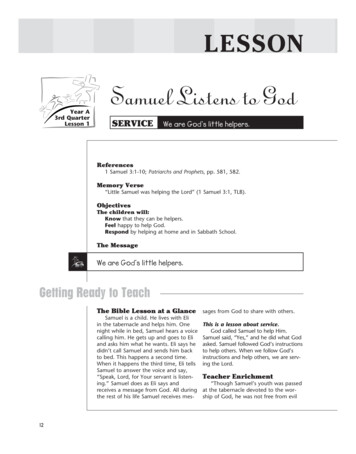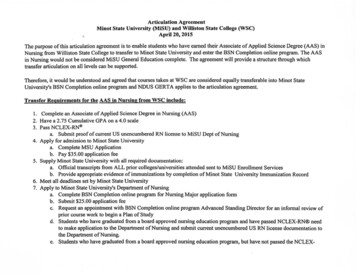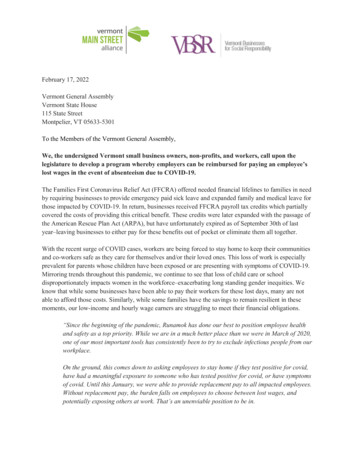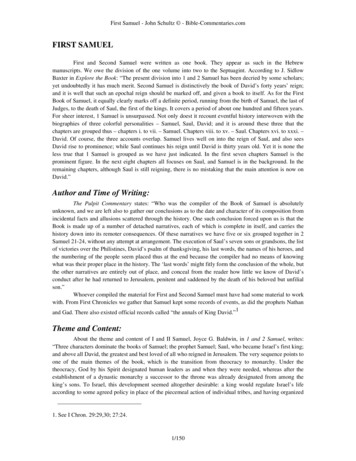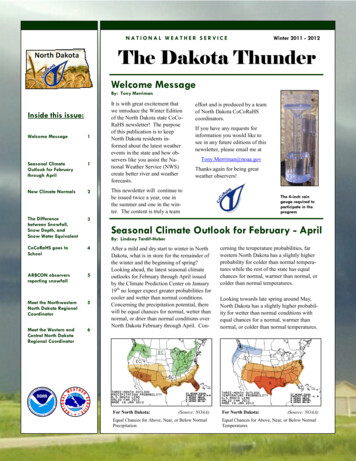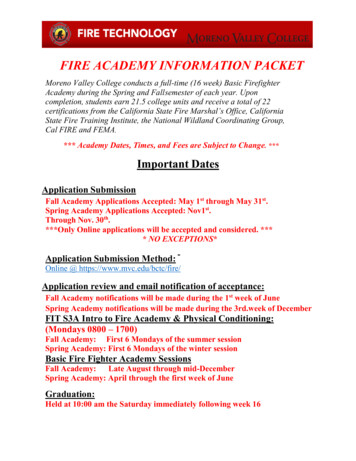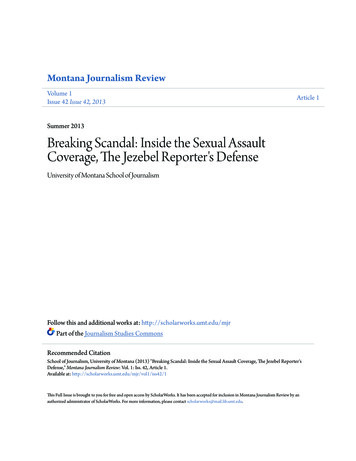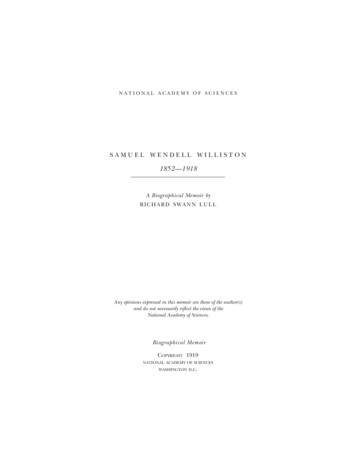
Transcription
national academy of sciencesSamuel wendell Williston1852—1918A Biographical Memoir byrichard swann lullAny opinions expressed in this memoir are those of the author(s)and do not necessarily reflect the views of theNational Academy of Sciences.Biographical MemoirCopyright 1919national academy of scienceswashington d.c.
SAMUEL WENDELL WILLISTON.1852-1918.By RICHARD SWANN LULL.PART I.—BIOGRAPHICAL SKETCH.In his immediate family, Prof. Williston stood as a conspicuous figure, as a scholar, a manof research, and one who by an innate superiority made himself what he was. For he owedlittle to his forebears other than the heritage of those sterling qualities which have made NewEnglanders in general so vital a force in the evolution of our national character and prestige;his scientific tendencies were an individual characteristic, and he stands as the only recordedWilliston to follow lines of scientific research.Williston's father, Samuel Williston, was a blacksmith, and, although a man of considerablenative ability, was totally untrained in the affairs of book men. He possessed, however, thatpioneer spirit which impelled so many eastern men to migrate to the developing West and seekin a new environment the elusive fortune which the East did not provide. Hence, while Williston was born in Boston, his development, in so far as environment exerted a control, was duealmost exclusively to the stimulating conditions of the newly invaded West. Here he spenthis boyhood. Of less robust physique than were his three older brothers, he sought companionship in whatever books came his way, reading without discrimination, largely because thevolumes were so few. His was a laudable ambition, however, for he very soon announced hisdetermination of being the most learned man in Kansas.His schooling was necessarily erratic, but none the less progressive, beginning with thealphabet, which was learned from the lettering on the cookstove, and continuing through theelementary schools of Manhattan, Kans., coupled, as has been said, with the most omnivorousreading. It was largely due to the influence of his mother, Jane Turner, that Williston and hisbrothers had any opportunity for schooling, for she determined that they should not sufferthe handicap of illiteracy against which her husband had to contend.Williston's first interest in paleontology was aroused in his seventh year. The boys hadoften gathered clams in the Blue River near Manhattan, but he found fossil clamshells on thesummit of a hill known as Blue Mont. He knew clams could not crawl on land, and accordinglysought of his father and Sunday-school teacher the solution of the mystery. Their explanation, had they but known, was like that by which the ancient Greeks sought to reconcile thepresence of mollusks' shells high upon the hills around the Mediterranean, and to the boy thesimple Biblical explanation of their being relics of the Deluge seemed at that time sufficientand served to awaken an interest in the Book of Genesis which he had not had before. Therewere also large stones filled with fossil shells of lower Permian age in the boys' favorite swimming hole, and these constituted Williston's first subjects for paleontological study.Fishing and hunting were the father's favorite recreations, and the preparation of thefish for cooking was young Samuel's task. Catfish, shad, and river sturgeon, the last with itsapparent lack of a vertebral column, in place of which there was a long fibrous rod, the notochord, gave rise to much speculation on the part of the boy, and this also served directly tostimulate his interest in natural history.Blue Mont College had been founded in 1859, but was merged into the State AgriculturalCollege in 1864, and two years later Williston was permitted to enter it as a student. Stimulated by his reading, he soon decided to become an author, but the nearest approach possibleat this time was to aid in the printing of 9, semiweekly newspaper at Manhattan. It was duringthis service that Williston's first literary contribution appeared—a supposedly humorous115
116SAMUEL WENDELL WILLISTON—LULL.account of the capture of Jefferson Davis, by the "printer's devil," who was at that time but13 years old.However, the value of learning the printer's trade did not outweigh that of further schooling, so Williston was sent back to the Agricultural College to continue his work. Here he readLyell's "Antiquity of Man," which made him a firm believer in evolution, despite its evidentantagonism to the teaching of the church. His friend and preceptor, Prof. Mudge of theAgricultural College, to whom he owed so much, remained opposed to the doctrine until hisdeath. Under Prof. Mudge, Williston studied natural philosophy, chemistry, botany,geology, zoology, veterinary science, mineralogy, surveying, spherical geometry, conic sections,calculus—a range of subjects possible only in the older days. In 1869 unrest again seizedWilliston, so in spite of the fact that he had not completed his collegiate education he decidedto seek his fortune, and after somewhat varied and disheartening experiences received theopportunity of doing railroad construction work, first in a clerical, later in an engineering capacity, until finally his health, which was still not at all robust, compelled him to give up such workand return to college. He completed his course in 1872, taking the bachelor of science degree,for he did not feel sufficiently proficient in Plato and Herodotus to make up the back work necessary for the degree of bachelor of arts. The panic of 1872 and 1873 made it impossible for himto obtain employment as a civil engineer. This circumstance proved to be of vital importancein his career, for, an early interest in medicine reawakening, he determined to study under thesupervision of the family physician, Dr. Patee, of Manhattan, a regular procedure in those days,when all that was required was that a student of medicine "read" in some physician's office forthree years, taking two courses of lectures of four or six months each, the second merely a repetition of the first, before coming up for his degree. Williston was given very little advice ordirection in his studies, except that he was told to study anatomy and physiology first. Formaterial he excavated in an old Indian burial ground, and the study of the bones thus exhumeddirected his attention to osteology, in which he later became so high an authority.Trouble in the Agricultural College in 1873 led to the dismissal of Prof. Mudge, and Williston,not understanding the situation, took the former's classes for a while. The apparent injusticeof the matter, however, made him so strong a partisan of Prof. Mudge that his manifestationthereof proved more than the authorities could stand and he was asked to leave. Otherwisehe might have succeeded his preceptor as a teacher of comprehensive "science."Williston's convictions concerning evolution, the result of absorbing the writings of Darwin,Huxley, Tyndall, and especially a German writer, Buecher, coupled with evidences from hisown observation, led to his delivering in the Congregational Church of Manhattan what hebelieved to have been the first public lecture in favor of evolution ever given west of the Mississippi Eiver. This was in February, 1874, and was, as he himself says, given with the cocksureness of youth, the address being lacking neither in positive nor dynamic statements. Such athing was daring in those days, nevertheless Williston was shocked at the severe criticismwhich he received in the local press.Meanwhile Prof. Mudge was carrying on geological explorations in western Kansas and haddiscovered the famous specimen of the Cretaceous toothed bird, Ichthyornis, which by pureaccident he sent to Prof. Marsh rather than to Prof. Cope, for whom he intended it. Marsh'sinterest was promptly stimulated, and in his characteristic way he immediately engaged Mudge tocollect fossils for Yale College. Mudge and a young assistant collected for a while in the northwestern part of the State, and then, as the hope of success seemed more promising in the SmokyHill Valley, decided to move thither. Fear of the Indians, however, proved to be too muchfor the assistant, and Mudge was forced to seek other aid. He engaged one of his formerstudents, H. A. Brous, who in turn invited Williston to accompany him, and after fulfilling anengagement to play the cornet in a band on July Fourth, Williston began what was to be hissubsequent life work as a paleontologist. Thus, as he says, " I t was this accidental and thoughtless decision that led to my life's devotion to Paleontology. Had I not gone with him in allprobability [to-day] I would have been a practitioner of medicine somewhere in Kansas."
ACADEMY OF SCIENCES.]BIOGEAPHICAL SKETCH.117Upon the completion of the summer's campaign, Williston went to the University of Iowafor the first course of medical lectures, but in the meanwhile Prof. Marsh's attention had beencalled to him, probably because the specimens collected by each man were marked with hisname. At any rate, in February Williston was invited to come to New Haven, and the offerwas eagerly accepted, for, as he says—I had lived practically all my life remote from scientific men, and authors were almost unknown. I had alwaysbeen a bookworm of the most accentuated type; I had grown to reverence, almost to worship, the writers of booksand especially of scientific books. * * * Such men as Huxley, Darwin, Dana, Gray, and Marsh were my idealsof all that was great and good. I thought them impeccable and almost infallible. My greatest ambition was to followhumbly in their footsteps—to write a book sometime myself and to make discoveries.Hence the first meeting of Prof. Marsh and the young westerner on March 19 or 20, 1876,was of great moment to the latter, and he records his impressions of the professor in no uncertain terms. The remainder of his visit was spent chiefly in the study of bird skeletons, and byMay 1 he was once more in the field in Kansas with a larger party, again in charge of Mudge.A long season was followed by Williston's return to New Haven, and in 1877 he was himselffor the first time placed in charge of the Kansas party, while Mudge was sent to Texas.Williston hoped very much to do original work, and with this end in view spent much ofthe preceding winter in studying fish skeletons in his own time, although under Marsh's direction,but when he asked permission to do actual research on the Cretaceous fishes which he believedProf. Marsh had no intention of studying it was denied him on the ground that it would distracthis attention from his regular duties. Williston soon realized that he would probably neverhave the opportunity of doing independent research on fossil vertebrates so long as he was Prof.Marsh's assistant, and this realization was to have a very important influence upon his futurecareer. The season of 1877 was very long and tiring, as he spent no fewer than 10 months inthe field, and it was during this period that his interest in insects, at this time chiefly beetles, wasaroused. On his return to New Haven, in January, 1878, he was determined to find some independent field of research, and after mature deliberation chose the Diptera, of which heeventually became the foremost American authority. But one more season, that of 1878, wasspent in collecting for Prof. Marsh, and from this work Williston was recalled in July. Thefollowing January a new contract was made between them, whereby Williston was permitted tocomplete his medical studies, which he did, taking his M. D. from Yale in June, 1880.Upon graduation, Williston was appointed assistant in osteology in Yale College, and in1881 he was placed on the Government pay roll as assistant paleontologist. In December ofthat year he married Miss Annie I. Hathaway, of New Haven, who survives him, with four oftheir five children. He remained with Prof. Marsh until 1885, although discontented, chieflyon account of the repressive policy of the latter. Hence in 1885 their relations were finallysevered, Williston receiving the degree of doctor of philosophy from Yale at commencement.He was now somewhat at a loss as to what course to pursue. He finally, however, refusedthe offer made by Dr. C. V. Riley, the United States entomologist, to serve as his chief assistant,and began the practice of medicine, in addition to which he acted as assistant editor of Science,under Prof. Scudder. In September he was appointed demonstrator of anatomy in the YaleMedical School, spending his days in New York in his capacity as editor and his evenings atYale in teaching. July of the next year brought him the title of assistant professor of anatomy,at a very small salary, which he was forced to eke out by his medical practice and by servingas town physician. It was as a health officer of New Haven in 1888 that Dr. Williston carriedthrough single-handed an epidemic of smallpox, caring for the sick and burying the dead witha singleness of purpose and devotion to duty which in war times would have won for him ahigh military honor. The year 1887 saw his appointment as professor of anatomy at Yale;1890 brought an offer from the Kansas Agricultural College which was declined, but an appointment as professor of geology in the University of Kansas was accepted in September of thatyear.Much that has been said of Prof. Williston's early life and struggles has been gleaned from amanuscript autobiography prepared by him in May, 1916, and kindly placed at the writer's
118SAMUEL WENDELL WILLISTON—LULL.disposal by Mrs. Williston. With the acceptance of the chair at Kansas, however, hethought the "recollections could with propriety end." The man had most assuredly foundhimself, and the upbuilding of his character and education was accomplished when he enteredthus upon the final phase of his scientific career. It is nevertheless to be regretted that heended his autobiography here, for his later career, while less romantic, was of greater importanceto science, both from the standpoint of teaching and of research.Dr. Williston's term of service in Kansas extended from 1890 to 1902, and to the title ofprofessor of geology were added those of professor of anatomy and dean of the School of Medicine. In addition, he was appointed a member of the State board of health, of which it is saidthat, largely because of his enthusiasm for work in behalf of the health of the community andhis ability to get things done by injecting new life into that body, it has since had the reputationof being one of the most efficient and progressive of the State boards of health. He served alsoas a member of the State board of medical examiners (1901-2). The year 1902 brought thecall to the University of Chicago as professor of paleontology, and there his affiliation lay withthe Department of Zoology until almost the close of his career, when he was made director ofthe Walker Museum in addition to his professorial duties.The manysidedness of Dr. Williston's accomplishments is abundantly attested by the variedcharacter of his employment, in which, at any rate in his earlier life, he was to a certain extentthe victim of circumstances. He could not always follow his greatest inclination, but invariablyrecognized opportunity and made the most of conditions which might well have discouraged alesser man, and, as the final results show, these opportunities all served to make the fruitionthe more abundant and valuable when he came to the fullness of his career.Williston was a born teacher. My greatest impression of this came at the initial meetingof the Paleontological Society in Cambridge in 1909 where, under President John M. Clarke'sadministration, a number of us were setting forth, usually from a read manuscript, our ideasconcerning the aspects of paleontology. Then rose Williston, whose paper was on "The Birthplace of Man," walked to the front of the desk, and without notes, in a simple conversationalmanner unfolded a marvelous exposition of his theme. Without a thought of disparagement of the other contributions, Williston's stands supreme as one of the finest and most inspiring presentations I have ever heard, and I knew at once why as a teacher he was eminent.The direct testimony of three of his students bears this out. Riggs says of him in a letter:His attic-study [at Chicago] and limited exhibition space became the Mecca of every paleontological pilgrim.This brought him in turn a limited but permanent fund to carry out his work; brought greater opportunity for extendedpublication; and brought also an honorary degree from his alma mater. These were the outward expressions of approval.There came with it a following of eager and enthusiastic students. They gathered in his little study and marveled at hislectures. They followed him regularly and often to the Field Museum for demonstrations. They marveled more athis enthusiasm and the broad scope of his conceptions than at the intrinsic interest of his subject.I am also permitted to quote from Prof. Case, who says:I believe that the '' Mark Hopkins and a log " idea of a university was never more nearly realized than in Dr. Williston. His knowledge of men and things was so wide and his acquaintance with many branches of science so intimatethat in the heat of a barren fossil field, or under the stars at night by the side of a camp fire, some bird, or flower, or fossil, some insect—"one of mine, I named it in 1870-odd "—would start a talk that held his little band of student assistantsenthralled until hunger, thirst, or sleep were forgotten.Prof. Williston was greatly interested in the scientific society of the Sigma Xi, and in anumber of educational addresses delivered under the auspices of that organization, emphasized very strongly the principles of training and practice for which it stands: a broad trainingin the sciences, but, above all, that productive scholarship which is manifest in a high qualityof original scientific research. Williston's influence in such education and his own attainments in line with these principles were recognized by the society, which conferred upon himits vice presidency from 1899-1901, and its presidency from 1901 to 1904. He was also amember of the Sigma Xi council for the years 1895 to 1904, 1907 to 1909, and 1910 to 1918,and was instrumental in forming the Chicago chapter in 1903.
w scIENcES.]BIOGRAPHICAL SKETCH.119Dr. Williston's addresses, which have been mentioned, are notable, and of the several whichhave been printed, the most important are those before the Kansas Academy of Sciences in1897, the Ohio State chapter of the Sigma Xi in 1903, the Kansas chapter in the same year,and the Yale chapter in 1917. His presidential address at the sixth biennial convention of thesociety was considered so important that part of it is incorporated into the appendix to theconstitution and is often read to initiates as the best summation of the principles for whichthe Sigma Xi stands. Still another noteworthy address was that delivered before the NationalEducational Association at Denver in 1909, on the subject, " Has the American college failed tofulfill its function?"It has perhaps been evident that Williston's inclinations would have led him at once intovertebrate paleontology as a field for research, with the probable result of more than doublingthe quantity and increasing with greater knowledge the quality of his output in that department of science; but here opportunity passed him by and circumstance drove him to entomology as an outlet for the pent-up energies of his creative mind. And his work in that fieldwas of the highest quality, as Riley's offer surely shows, for, as Williston himself says, "Had Iaccepted the place of chief assistant perhaps I would now be the United States entomologist."Williston's research began with the beetles, but he speedily turned his attention to the flies,the results being published first in 1877, a few papers together in 1878, then exclusively from1880 until 1886, when his second paleontological paper appeared. From 1887 until 1896 theentomological papers were still the bulk of his output, but from this time on those in paleontology became more and more numerous until the insect research practically ceased in 1899.In 1908, however, Williston did a remarkable thing in laying aside his paleontology and takingup once more the study of the flies, his purpose being to make a final (third) revision of theirtaxonomy and publishing his "Manual of the North American Diptera." In this final volume,which is both compendious and minute in detail, Williston shows a breadth and accuracy ofknowledge surprising in any case and doubly so when one considers that he had done no researchon the flies for more than a dozen years.Williston also wrote of recent zoology, mainly on the habits of creatures which came casually within the scope of his observation; he wrote of sanitation and river pollution, of mankindin the abstract and specifically when called upon to pay tribute to departed colleagues. Buthis main research, as with his teaching, lay with the vertebrates of the geologic past, and hereinthe volume of his work equals that on the insects and in the prejudiced eyes of a fellow vertebratist has a value which greatly exceeds it. For the vertebrate work is not solely systematic,as was the entomological, but gave opportunity for broad generalizations, anatomical, evolutional, and philosophical, of a very high order.At the University of Kansas the local paleontology naturally attracted Williston's attention,partly because his initial work with Prof. Mudge in 1874 was in the rich Niobrara Cretaceous,and because the work was in part that of the Kansas University Geological Survey. For morethan 12 years, with the material secured by Dr. F. H. Snow and Judge E. P. West as a nucleus,Williston sought to build up the university collections, embodying the scientific results inVolumes IV and VI of the State survey. This research deals largely with the creatures of theNiobrara chalk, all of which are marine or aerial, with the exception of a rare dinosaur or two.At Chicago, Williston found that his predecessor, Dr. Baur, who had also served for anumber of years under Prof. Marsh at Yale, had already made some collections of Permianmaterial, and this fact gave the trend to his future work. As Mr. Riggs (letter) says of him:He made expeditions into the Trias and then into the Permian of the Southwest. Year after year his collectorswere sent into this field and soon publications announced their discoveries. Despite the rigors of climate, the insufficiency of funds and the protests of his field men, he clung to this field and its problems for 12 years, ending onlywith his life. He unearthed a fauna which has been much sought but little known. With only a single preparator,with no illustrator but his own pen and brush, he made known this strange and primitive reptilian fauna with acelerity and acumen which astounded his co-workers.
120SAMUEL WENDELL WILLISTON-LULL.IMEltonfvo xvn;In this exploration Williston found great difficulties in his way, for he says in "AmericanPermian Vertebrates" (p. 2):The [Texas Permian] beds are the most difficult of exploitation of any known to me in a field experience of 35years. Usually the fossils are more or less hidden in concretionary nodular masses, almost invisible or indistinguishable to the untrained eye until they have been broken up and weathered, when the inclosed fossils have lost muchof their value. Rarely single bones and even whole skeletons are found in clay deposits almost or quite free frommatrix, but many such are not to be expected.Finally, however, as a result of painstaking research, bone beds, notably the Cacops beddiscovered by Paul Miller in 1909, were found which yielded considerable more or less perfectmaterial. It was also Williston's privilege to study the Marsh collection of Permian materialat Yale, one result of which was the unearthing of specimens from storage, the perfection ofwhich was totally unsuspected, notably the practically perfect Limnoscelis type. As a result,Williston, supplemented by E. C. Case, who also had access to the American Museum material,has given us a knowledge of Paleozoic air-breathing vertebrates, Amphibia and Reptilia, whichwas almost unhoped for. I t was largely because of the quality of his research in this line thatYale University honored herself by admitting Prof. Williston to the doctorate for the thirdtime, as the degree of doctor of science was conferred upon him in June, 1913.Williston's life is a stirring tale of one who rose superior to heredity, environmentallimitations, and the petty discouragements of life, especially those due to financial restrictionsin the pursuit of a costly science. He immortalized himself not only in the amount of hispublished research, of over 4,000 printed pages, some of them bearing the impress of genius,but in the knowledge and inspiration which he instilled into those whose privilege it was tosit at his feet. Certain of these, such as Branson of the University of Missouri, Sellards andBeede of the University of Texas, Logan of the Mississippi Agricultural College, and Mooreof the University of Kansas, have followed lines of work more strictly geological; but Caseof the University of Michigan, Biggs of the Field Museum, Brown of the American Museum,Moodie of the University of Illinois, and Mehl of the University of Missouri form a groupwhich will worthily carry on his vertebrate research. Vale magister !PART II.—PUBLISHED RESULTS.CONTRIBUTIONS TO ENTOMOLOGY.The list of Dr. Williston's published writings embraces a considerable range of subjects,and in the two departments of entomology and vertebrate paleontology includes works of highauthoritative value. Those in entomology being outside the narrow limits of the present writer'sresearch, he must turn to others for a critical review. Dr. J. M. Aldrich, of the United StatesNational Museum, has kindly sent me an estimate of this department of Williston's activities,and with his permission I extract from it the following:Williston never held an official entomological position. But he found time to do much valuable work as a pioneerin dipterology. * * * His interest in the flies began to be serious about 1878. At this time Osten Sacken hadreturned to Europe, and there was not a single American student of the order but Edward Burgess, the Boston yachtdesigner, who published only one small paper. So Williston was virtually alone on the continent. In the absence ofguidance, he plowed his way by main strength (as he often narrated to the writer) through descriptions of species untilhere and there he made an identification, which served as an anchor point for a new offensive. He had few definitionsof genera, so had to work backward from the species. After a year or two of this tedious and time-wasting effort, hecame upon Schiner's Fauna Austriaca, in which the Austrian families, genera, and species of Diptera as known up to1862-1864 are analytically arranged and succinctly described. To his immense relief and satisfaction, he now foundthat all his American flies could be traced to their families, and most of them to their genera, in this fine work. Hewas so impressed by the saving of time accomplished that his own publications coming later show the effect of thiaearly experience on every page; everywhere he has the beginner in mind and is clearing the way for him.In a few years he began publishing tentative papers analyzing the American families and genera of the flies. Thesehe extended and enlarged in a pamphlet in 1888, and again in a bound volume in 1896; and in 1908 published a thirdedition still more complete, with 1,000 figures, his well-known "Manual of Diptera." This third edition is his maincontribution to entomology. I t is a handbook unapproached by anything else dealing with a large order of insects.
ACADEMY OF SCIENCES.]PUBLISHED RESULTS.121From necessity he published it at his own expense; it was eight years before the receipts from sales covered the costof printirjg, but happily he lived to see this consummation.His other papers of his early period, 1881-1889, dealt with Asilidee, Conopidss, Tabanidee, and smaller groups,and especially with Syrphidse, in which his fine monograph of 1886 is still in universal use, and by the taxonomicgenius of its author has created in the United States an ineradicable belief that the family is an easy one, well adaptedfor the beginner to publish in; a mistaken belief, but highly complimentary to the monographer.From 1890 his more important papers were concerned with tropical Diptera (Mexico, St. Vincent, Brazil), andwith bibliography. As Ms official duties grew more exacting, he gradually abandoned entomology, but he had as manyfarewell appearances as an opera singer, for he could not resist the temptation to come back again and again. Evenas late as the spring of 1917, when he was visiting the writer and reveling once more in a collection of Diptera, his oldenthusiasm came back so strongly that he planned describing some new genera, and in fact did publish one (AnnalsEnt. Soc. Amer., vol. 10, p. 23). But after 1896 he did little work on the order exceptin preparingthe third editionof his Manual, which cost him two years of arduous work, as he drew 800 figures with his own hand. His deep interestin genera and his very wide acquaintance with them, together with his universally recognized taxonomic ability,made him, in the period 1890-1900, the peer of Osten Sacken, Brauer, and Mik as a world authority in Diptera.PALEONTOLOGICALRESEAECH.*The first of Prof. Williston's paleontological papers appeared in 1878—a brief discussion ofthe American Jurassic dinosaurs *—and was followed in the next year by an expression of opinionon the dinosaurian origin of birds.2 One or two other dinosaur pape
Blue Mont College had been founded in 1859, but was merged into the State Agricultural College in 1864, and two years later Williston was permitted to enter it as a student. Stim-ulated by his reading, he soon decided to become an author, but the nearest approach possible at this time was to aid in the printing of 9, semiweekly newspaper at .
